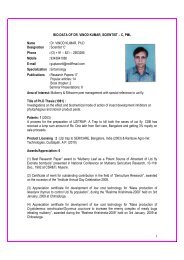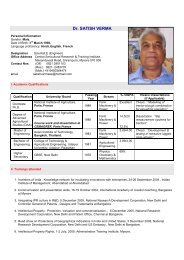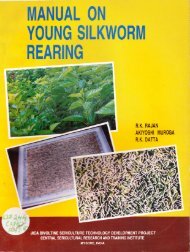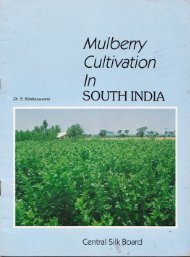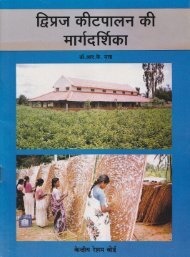Silkworm
A Treatise on the Acid Treatment of Silkworm Eggs - Central ...
A Treatise on the Acid Treatment of Silkworm Eggs - Central ...
You also want an ePaper? Increase the reach of your titles
YUMPU automatically turns print PDFs into web optimized ePapers that Google loves.
lntroduction<br />
The diapause, in insects, is a method of overcoming unf avourable period caused either by physiologically<br />
unfavourable conditions or non-availability of food. For the silkworms ol the temperate region, both<br />
these conditions will prevail during winter and thus they have developed the diapausing (hibernating)<br />
character lo overcome this period.<br />
The phenomenon of diapause is environmentally, physiologically and genetically controlled. Acid<br />
treatment is just a method to change the physiology by blocking certain activities and inducing several new<br />
biochemical reaclions lor the continuous development of the eggs.<br />
Diapause eggs are more customarily relerred to as hibernating or bivoltine eggs, while lhe nondiapause<br />
ones as non-hibernating or multivoltine eggs.<br />
Left to themselves, the diapausing eggs do not hatch on incubation. However, it is possible to make<br />
them hatch artif icially by providing various physicalor chemical stimuli. The various physical and chemical<br />
agents/methods by which it is possible to block or lerminate the diapause are given in Table-1 . Though<br />
several artificialmethods have been devised, the immersion of diapausing eggs in Hydrochloric acid (HCl)<br />
has been the best choice and most widely adopted technique for immediate hatching, lrom the technical<br />
as well as practical points of view, both at the laboratory as well as commercial leveis of bivoltine seed<br />
production.<br />
To bring a shift f rom diapause to non-diapause type, changes in the incubation schedule like shorter<br />
exposure to light and low temperature during incubation, changes in the rearing conditions like continuous<br />
high temperature rearing, low temperature during early stages and high temperature during the late<br />
stages, cocoon preservation at high temperature, coupled with selection, are essential.<br />
The scope of this booklet however has been restricted to methods ol acid treatment of diapausing<br />
eggs for artificial hatching and related changes. This has been dealt with in two parts, Part - | dealing exclusively<br />
with the methods of Hydrochloric acid treatment and Parl-ll with the physiological changes<br />
associated with it.<br />
Table<br />
Agents/Methods of Artificial Hatching<br />
Physical Stimulants<br />
1. Artilicial overwintering by subjecting to low temperature*<br />
2. lmmersion into hot water<br />
3. Electrical stimulation using high voltage<br />
4. Friction by feather/hard brush<br />
5. Enforcement of high atmospheric pressure<br />
6. Use of ultra high frequency vibrations<br />
7. Use of radiated sunrays or exposure to sun-shine<br />
8. Use of ultra purple rays/ultra short waves<br />
9. Expozure to Oxygen<br />
Chemical Stimulants<br />
Hydrochloric acid .<br />
Nitric acid<br />
Sulphuric acid<br />
Aqua - regia<br />
Acetic acid<br />
Sodium chloride<br />
Hydrogen peroxide<br />
Enzyme treatment<br />
Ozone treatment<br />
. Most commonly used methods/agents


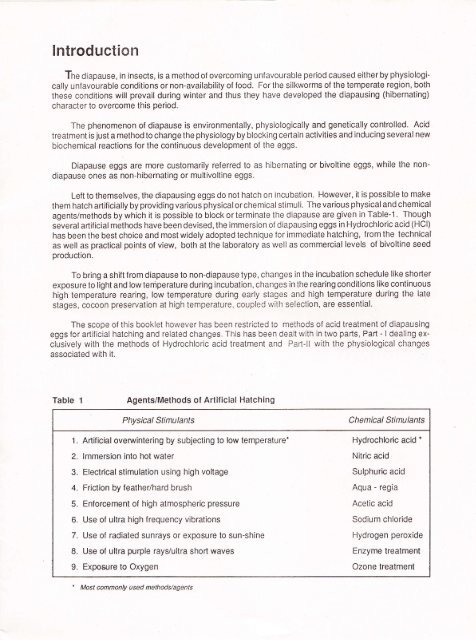

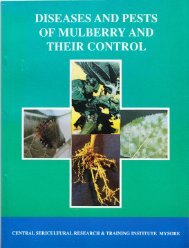

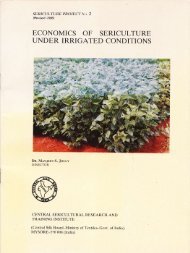
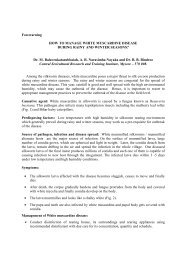
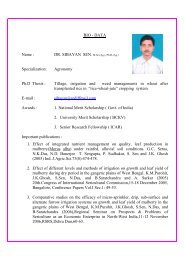
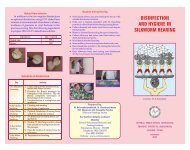
![E}A]\GALORE](https://img.yumpu.com/54052619/1/190x260/eagalore.jpg?quality=85)

